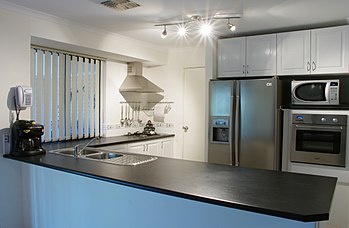 |
| Modern kitchen (Photo credit: Wikipedia) |
Every kitchen should have windows on two sides of the room, and the sun should have a free entrance through them; the windows should open from the top to allow a complete change of air, for light and fresh air are among the chief essentials to success in all departments of the household. Good drainage should also be provided, and the ventilation of the kitchen ought to be even more carefully attended to than that of a sleeping room. The ventilation of the kitchen should be so ample as to thoroughly remove all gases and odors, which, together with steam from boiling and other cooking processes, generally invade and render to some degree unhealthful every other portion of the house.
There should be ample space for tables, chairs, range, sink, and cupboards, yet the room should not be so large as to necessitate too many steps. Undoubtedly much of the distaste for, and neglect of, "housework," so often deplored, arises from unpleasant surroundings. If the kitchen be light, airy, and tidy, and the utensils bright and clean, the work of compounding those articles of food which grace the table and satisfy the appetite will be a pleasant task.
It is desirable, from a sanitary standpoint, that the kitchen floor is made impervious to moisture; hence, concrete or tile floors are better than wooden floors. Cleanliness is the great desideratum, and this can be best attained by having all woodwork in and about the kitchen coated with polish; substances which cause stain and grease spots, do not penetrate the wood when polished and can be easily removed with a damp cloth.
The elements of beauty should not be lacking in the kitchen. Pictures and fancy articles are inappropriate; but a few pots of easily cultivated flowers on the window ledge or arranged upon brackets about the window in winter, and a window box arranged as a jardiniere, with vines and blooming plants in summer, will greatly brighten the room, and thus serve to lighten the task of those whose daily labor confines them to the precincts of the kitchen.
The kitchen furniture.
The furniture for a kitchen should not be cumbersome and should be so made and dressed as to be easily cleaned. There should be plenty of cupboards, and each for the sake of order, should be devoted to a special purpose. Cupboards with sliding doors are much superior to closets. They should be placed upon casters so as to be easily moved, as they, are thus not only more convenient but admit of more thorough cleanliness.
Cupboards used for the storage of food should be well ventilated; otherwise, they furnish choice conditions for the development of mold and germs. Movable cupboards may be ventilated by means of openings in the top, and doors covered with very fine wire gauze which will admit the air but keep out flies and dust.
For ordinary kitchen uses, small tables of suitable height on easy-rolling casters, and with zinc tops, are the most convenient and most easily kept clean. It is quite as well that they are made without drawers, which are too apt to become receptacles for a heterogeneous mass of rubbish. If desirable to have some handy place for keeping articles which are frequently required for use, an arrangement similar to that represented in the accompanying cut may be made at very small expense. It may be also an advantage to arrange small shelves about and above the range, on which may be kept various articles necessary for cooking purposes.
One of the most indispensable articles of furnishing for a well-appointed kitchen is a sink; however, a sink must be properly constructed and well cared for, or it is likely to become a source of great danger to the health of the inmates of the household. The sink should if possible stand out from the wall, so as to allow free access to all sides of it for the sake of cleanliness. The pipes and fixtures should be selected and placed by a competent plumber.
Great pains should be taken to keep the pipes clean and well disinfected. Refuse of all kinds should be kept out. Thoughtless housekeepers and careless domestics often allow greasy water and bits of table waste to find their way into the pipes. Drain pipes usually have a bend, or trap, through which water containing no sediment flows freely; but the melted grease which often passes into the pipes mixed with hot water, becomes cooled and solid as it descends, adhering to the pipes, and gradually accumulating until the drain is blocked, or the water passes through very slowly. A grease-lined pipe is a hotbed for disease germs.

No comments:
Post a Comment